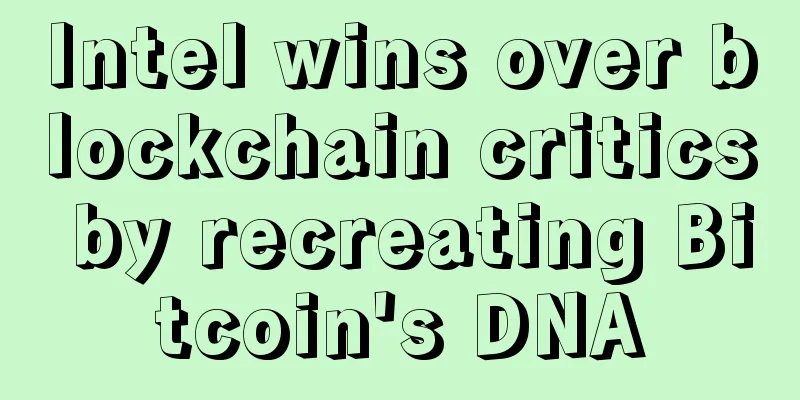Intel wins over blockchain critics by recreating Bitcoin's DNA

|
Rage Comment : The research and development of blockchain technology reflects the difficulty of establishing a new technology. Intel has broken the norm by innovatively rebuilding the Bitcoin gene and has won the support of technical experts. Intel has created a new consensus algorithm PoET (Proof of Elapsed Time), which is believed by some senior technicians to promote consensus among blockchain networks. At the same time, there are also voices questioning this mechanism. Translation: Flora In the process of in-depth research and development of blockchain, we found that the creation of any new technology is extremely arduous. To make these interesting ideas stand out, it takes not only the full conception of a new financial database, but also sufficient peer review, testing and time. Of course, this process is complicated and requires the participation and guidance of technology giants such as IBM and JPMorgan Chase, so that they have the confidence to eventually surpass more famous open source innovations such as Bitcoin and Ethereum. While these contributions have made headlines, they have received little praise from the open source and enterprise communities. Breaking that trend is Intel, which has won over even the usually fickle technologists by innovatively rebuilding the technology behind Bitcoin. One of the main contributions is the runtime proof mechanism (proof-of-elapsed-time (PoET)). It is a variable in the system that Bitcoin uses to confirm that all computers in the network agree that transactions have actually occurred. This mechanism was just made public at the beginning of this year. Cryptographers may be more aware of the role of this high-tech tool, which can solve the computational problem of "random leader election" and the problem of "selecting who to create the next transaction block." Although the mechanism has not received much attention, some senior technical experts believe that this mechanism is novel and radical and will promote consensus among blockchain networks. PoET was invented by developers at Intel and can only be used on a certain type of computer produced by Intel, which is called a trusted execution environment (TEE). On the one hand, supporters believe that this is a more environmentally friendly algorithm than Bitcoin's proof-of-work (PoW); on the other hand, many open source developers have questioned the fact that the mechanism requires trust in Intel for widespread use. Christopher Allen, chief architect of Blockstream, a member of the Hyperledger consortium and one of the largest financial backers of bitcoin development, is a veteran observer of the blockchain space and responded to the prospect of the mechanism. Christopher Allen Allen told CoinDesk:
Mix and Match One of the reasons why Allen praised Intel's contribution is that it provides a variety of choices and consensus algorithms, which Allen believes allows users to build private blockchains that meet their requirements. Allen said:
Allen also mentioned that the working group has been discussing how to build an optimal architecture that allows users to choose from a variety of consensus algorithms. This is PoET, a unique blockchain offering available in Sawtooth Lake that Allen calls an analog to PoW and perhaps the best alternative for private blockchains. He said PoET borrows from the Nakamoto consensus algorithm PoW, which has more advantages than Practical Byzantine Fault Tolerance, an algorithm used by blockchain consortiums such as Hyperledger and Stellar. One of them is that the mechanism has a large number of nodes and can still operate when most nodes are unavailable, making it more trustworthy. One drawback of this mechanism is settlement finality: users need to wait for a certain number of blocks before they can be fully sure that their transaction is recorded. But despite all of the mechanism’s unique features, there is a perception that it doesn’t make sense for both private and public blockchains. “It’s very easy to create layers of obfuscated code that ultimately do not contribute to the underlying security model,” said Bryan Bishop, a contributor to Bitcoin Core. Trust in Intel The main criticism that has emerged is that participants need to use Intel hardware such as SGX to perform cryptography and that this needs to be done in a protected area, where these operations cannot be inspected or tampered with. In theory, what you can know is that the blockchain is full of transactions, that these transactions will be distributed at certain time intervals, and that these transactions are correct. You can also know that these records cannot be tampered with because they are encrypted. "PoET uses special processor functions rather than operations to regulate the frequency of blocks," said Dan Middleton, project manager for Sawtooth Lake, using protected areas on the chip to explain his view that "the cryptography performs as designed." He further stated that “this ensures a return to ‘one-cpu-one-vote’,” echoing a point made in Satoshi Nakamoto’s Bitcoin white paper. But compared to PoW, PoET has many obvious differences. PoW provides an untrustworthy system, while Bishop believes that Intel's approach achieves "maximum trust." This is why both Bishop and Allen questioned whether this consensus algorithm can serve public blockchains like Bitcoin and Ethereum. As Bishop put it, "It's like giving Intel the keys to the kingdom." Bryan Bishop Bishop said:
Future Possibilities While this mechanism may not be the most perfect safeguard for decentralization advocates, it hasn’t stopped Intel from being part of the conversation at conferences. In fact, now may be the time for the larger market to evaluate how this concept evolves and is applied to other processors. In terms of testing the protocol, users do not need to purchase TEEs. Middleton added that anyone interested in the protocol can now test how the blockchain works in a distributed network. Allen believes that the use of TEEs is why PoET is not as popular as the PoW protocol, or one day the PoS protocol, which are two more mature protocols that allow participation through specific computer hardware. But he also acknowledged that other possibilities could arise if other hardware vendors implemented the new algorithm. He said:
Like all ideas, this one will ultimately be determined by the market, but for now, Intel's work appears to have turned a corner, moving toward greater deliberation and consideration. |
<<: Blockchain attracts central banks, Danes consider minting e-krona
>>: Stremio Selects WINGS DAO Management Platform for AdEx Crowdfunding Campaign
Recommend
Look at your marital status
Look at your marital status People with upward cr...
OpenBazaar leads the pack with three nominations for the 2016 Blockchain Awards
Coin Center and Blockchain.info have announced th...
A diagram of a woman's false broken palm
In ancient times, a woman with a broken palm was ...
People with these eyebrow characteristics have good career development. People with these eyebrow shapes have good career development.
No eyebrows People without mixed eyebrows are per...
How to tell the fortune of a woman with a mole on her chin
A woman with a mole on her chin If a woman has a ...
Chin predicts your personality and love
Chin predicts your personality and love The chin ...
Is it good to have an upturned nose? It means that your fortune and career are both bad.
From the perspective of physiognomy, the nose is ...
Does a mole on the forehead mean bad luck in life?
A person's life actually has a trajectory. Ev...
Survey: 40% of Goldman Sachs clients already have exposure to cryptocurrencies
U.S. banking giant Goldman Sachs has officially c...
Wu Qu Tan Lang in Fude Palace_Face Analysis
Wu Qu is resolute and resolute, hard-working, una...
Filecoin Community Highlight: Slate
On top of the Filecoin protocol, application deve...
Is it good or bad to have a mole on the ear? What does it mean?
It is normal to have moles on the body, and the l...
We must be vigilant! The US inflation problem may trigger a new round of global financial crisis
Data released by the U.S. Department of Labor sho...
Teach you how to identify a cruel woman's face
I believe everyone has heard the saying that appe...
Is it really possible to exchange currency in disguise through Bitcoin? Industry insiders: Theoretically, it is possible, but it is not cost-effective
The People's Bank of China (PBOC) and the Sta...









